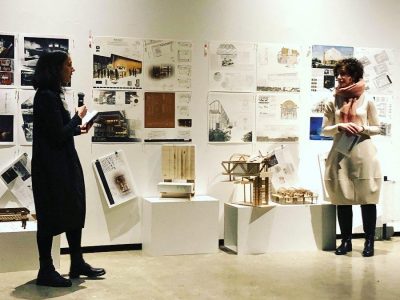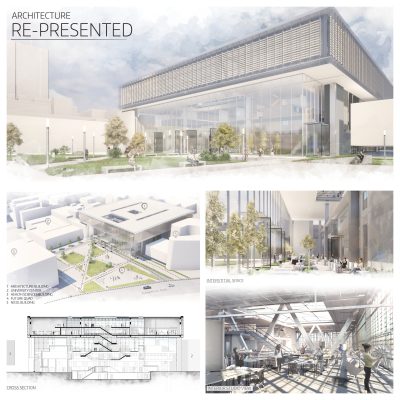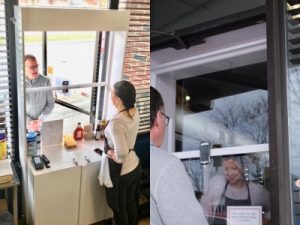Winners of 2020 Stantec Architecture Prize for Excellence in Comprehensive Studio Projects

Congratulations to the 2020 winners of the Stantec Architecture Prize for Excellence in the Comprehensive Studio Project!
The prize, established in 2007 by Stantec Architecture Ltd., is awarded annually by the Director of the Azrieli School of Architecture and Urbanism on the recommendation of the Stantec Architecture Prize Selection Committee to students at the school. Recipients are selected based on excellence in their comprehensive studio project.
“The 2020 Stantec Architecture Competition once again put on display the extraordinary comprehensive professionalism of the students in the graduate Gateway Studio,” says Professor Sheryl Boyle, the coordinator and one of four faculty teaching the Studio.
“The students demonstrated their excellence in individually compiling a set of working drawings, as well as elegant competition panels, detailed models, and fabrication detail explorations. The exhibition of the work in the school for the competition allowed undergraduate students to see the kind of technical and poetic rigor that they will produce in the graduate program. I’m really proud of what they all achieved in the semester and congratulate the winners.”
The selection committee consisted of two representatives from Stantec Architecture Ltd. and two graduate students from the Azrieli School of Architecture and Urbanism.
Natalie Petricca and Deanna Brown from Stantec, accompanied by Devon Moar (MAS student) and Kristin Washco (PhD student), did a critical blind review of the 57 projects on January 13 as students from all years looked on.
The first-place winner took home $1,000; second place winners $500; honourable mentions $200; and special mentions for drawing and modeling $100.

1st Place: Laura Clark
REACT[IANO] Factory + Recital Hall
REACT[IANO], a grand piano factory, inhabits the light and delicate structure of the former Hamilton Gear Factory, accompanied by supplementary programming including instrument practice facilities and a recital hall. Users are encouraged to circulate through the primary volume where production occurs to gain an understanding, visually and aurally, of how the instrument they are about to play or listen to was created.
Jury Comment: Laura’s approach to her project was incredibly thoughtful and compelling. She used her chosen program of a piano factory to inform all aspects of the project, from the overall planning to the design of the acoustic panels. Her sensibility for representation is exemplary.

2nd Place: Gregory Juneau
Distilling Architecture: Spirit Studio
Spirit Studio is an adaptive reuse of an early 20th-century building from an antique shop to a distillery workshop. It employs extensive passive and active strategies to reduce its environmental impact. It also acts as a prototype for the creation of locally sourced, locally produced, and site-specific distillery workshops that can be replicated worldwide to alleviate the global impacts of the distillation industry.
Jury comment: Greg did an excellent job of turning the process of gin distillation into a thoughtful architecture. His drawings are beautifully presented, and the renderings are very compelling.

2nd Place: Walter Fu
Division Workshop
Located next to a blossoming maker community, the DIVISION workshop serves as a workspace and testing ground for experts and newcomers alike to the world of the Digital Vernacular. With a space dedicated to CNC woodworking and another dedicated to concrete mixing and casting, the project embraces both wood and concrete as codependent materials, pushing them into the age of digital design and fabrication.
Jury comment: Walter took a very careful approach to the adaptive reuse of an existing building and should be commended on his project. His thinking in three dimensions through digital tools and model making is evident and resulted in a beautiful project.

2nd Place: Joel Tremblay
NOMAD – Overland Outfitter
NOMAD is an adaptive reuse project of an industrial building in Toronto, once occupied by Hamilton Gears, a metal machine fabrication workshop that made components for the St. Lawrence Seaway locks, the Avro Arrow, and the Rogers Centre. The historical qualities of the site laid the foundation for a new kind of industrial workshop: an Overland Outfitting base paired with educational and research initiatives.
Jury comment: Joel chose a very unique program, and his passion for it shows through in his attention to detail and his methods of representation. The planning of the building in plan and section is quite thoughtful, and he successfully tackled the challenging site conditions.

Honourable Mention: Khadija Khadija
Architecture Re-Presented
The proposed School of Architecture reasserts itself at the heart of the campus. A large span truss system hovers over the existing building and partially over the University Centre, creating an indoor public walkway that provides a new entrance to both buildings. This space will host a café and offer opportunities for students to display their work. Large operable doors can be opened during the summer.
Jury comment: Khadija’s approach to the adaptive reuse of the Architecture Building was thoughtful and well represented. Her connection of the new to the old through the existing system of streets and stairs and her addition of a winter garden to the south would be a welcome addition to the campus.
Honourable Mention: Brooke Zacharuk
Architecture in Time

Honourable Mention: Brooke Zacharuk
Architecture in Time
The addition over the Azrieli School of Architecture & Urbanism embeds an ethos of well-being and sustainability through natural materials that embrace transiency. The intention is to showcase the therapeutic potential of natural materials to improve the experience of students and encourage alumni to transmit this spirit into the buildings they design in the future.
Jury comment: Brooke’s use of sustainable practices to design her adaptive reuse of the Architecture Building was unique among her peers. Her passion for and understanding of sustainable practices were very evident in her project.

Honourable Mention: Brian Cheung
Artist Village
The proposed development intends to create a centralized artist village and a hub for different disciplines of craftspeople, designers, and artists. The ultimate goal is to enable collaboration through visual connection as well as common space for exhibition and social events. The exterior lighting effect resembles an internal lantern that lights up the heart of a collaborative central space of the building.
Jury comment: Brian’s project was beautifully represented and detailed. The drawings and model were well crafted and told the story of how the space would be inhabited.

Special Mention for Drawing and Modelling: Kristine Prochnau
Bubblewrap Paradise
Could our built environment teach us to live with more humility and respect not only for the planet we depend on, but the people we share it with? By living quite literally in a bubble we would force ourselves to value and conserve, reuse and grow all resources available to us.
Jury comment: Kristine’s drawings and model were creatively presented and helped to tell the story of her project. Her drawings were atmospheric and playful and reflected the impending doom she wrote about in her introduction.
Honourable Mention: Nicholas Bava
Jury comment: Nicholas’ mapping of the circulation through the site and the Architecture Building were very uniquely represented. His drawings beautifully represent light and shadow and the atmosphere of his proposed intervention.
Special Mention for Drawing and Modelling: Emma Goodwin
Jury comment: Emma’s facility with representation through hand drawing, digital representation, and model making are beautiful. Her drawings and models help viewers get a sense of how her spaces will feel.
Many thanks to Stantec for continuing their engagement with students and the school through this highly anticipated and professional event.


